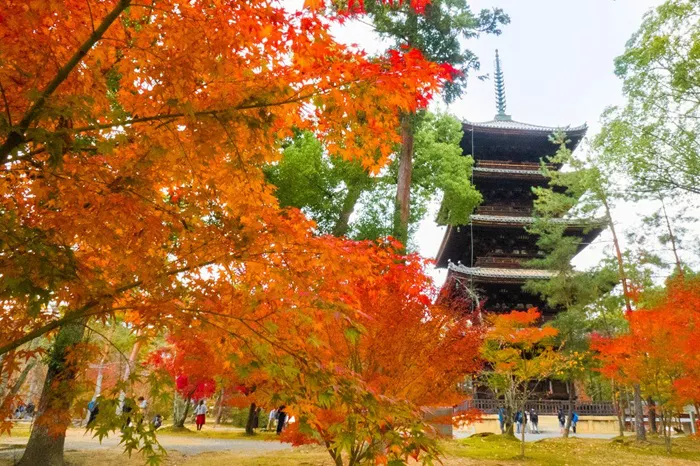Ninnaji is a famous Buddhist temple located in Kyoto, Japan. It holds a very special place in Japanese culture and Buddhist history. This temple is not just a place of worship but also a symbol of peace and traditional art. Understanding Ninnaji helps us learn about Buddhist teachings and Buddhist temples in general.
The History of Ninnaji
Ninnaji was founded in 888 AD by Emperor Uda. It was built during the Heian period, a time when Buddhism was growing strong in Japan. The temple served as a center for the Omuro school of Shingon Buddhism. Over the centuries, Ninnaji was rebuilt several times due to fires and wars, but it has kept its original style and meaning.
Emperor Uda and the Temple’s Founding
Emperor Uda wanted a peaceful place where Buddhist monks could study and practice their faith. He chose a quiet area in Kyoto to build Ninnaji. This was important because it helped spread Buddhism’s message of compassion and mindfulness throughout Japan.
Reconstruction and Preservation
Despite being damaged many times, Ninnaji was carefully rebuilt using traditional methods. This shows how important the temple is to both religion and culture. The temple complex we see today still reflects the temple architecture styles from the Heian period, making it a living museum of history.
Significance of Ninnaji in Buddhism
Ninnaji is more than just an old building. It is a place where Buddhist practice and teachings continue. The temple is a center for meditation, rituals, and learning. It also holds many sacred Buddhist statues and scriptures that attract followers and visitors from around the world.
Center for Omuro Shingon Buddhism
Ninnaji is famous for the Omuro sect, a branch of Shingon Buddhism. Shingon Buddhism focuses on esoteric teachings that emphasize meditation and rituals. At Ninnaji, monks study these deep teachings to understand the true nature of reality and enlightenment.
A Place of Meditation and Peace
The temple gardens and buildings create a peaceful environment. Visitors and monks alike come here to meditate and find calm in their busy lives. This reflects the Buddhist goal of inner peace and harmony with nature.
Architectural Features of Ninnaji
Ninnaji is well-known for its unique Buddhist architecture. The design combines spiritual symbolism with natural beauty.
Main Hall and Pagoda
The main hall, called the Kondo, is where important Buddhist ceremonies happen. It houses statues of Buddha and other deities. The five-story pagoda is another highlight. It symbolizes the five elements of earth, water, fire, wind, and space, which are important in Buddhist philosophy.
Gardens and Landscape
Ninnaji’s gardens are designed to reflect Buddhist ideas of nature and impermanence. The landscape includes ponds, trees, and paths that encourage walking meditation. The changing seasons, with cherry blossoms in spring and colorful leaves in autumn, add to the temple’s beauty.
Cultural Importance of Ninnaji
Ninnaji is not only a religious site but also a cultural treasure of Japan. It was declared a UNESCO World Heritage Site as part of the “Historic Monuments of Ancient Kyoto.” This recognizes its importance in preserving Japanese heritage.
Art and Festivals
The temple holds many festivals throughout the year, celebrating Buddhist holidays and seasonal changes. Traditional music, dance, and tea ceremonies are common. These events help keep ancient customs alive and connect people with Buddhist culture.
Role in Education and Tourism
Ninnaji is also a place where people learn about Buddhism and Japanese history. Tourists from all over the world visit to see the beautiful buildings and peaceful gardens. This helps spread knowledge about Buddhist values and the importance of protecting cultural sites.
How to Visit Ninnaji
For those interested in experiencing Ninnaji, it is located in western Kyoto, Japan. Visitors can explore the temple grounds, see the architecture, and enjoy the gardens. The temple also offers guided tours that explain the history and religious significance in simple terms.
Best Time to Visit
Spring and autumn are the most popular times to visit Ninnaji. The cherry blossoms in spring and colorful leaves in autumn create stunning views that enhance the temple’s serene atmosphere.
Respectful Behavior at the Temple
When visiting any Buddhist temple, including Ninnaji, it is important to be respectful. This means speaking quietly, not touching sacred objects, and following the rules of the temple. Visitors should also try meditation or prayer if offered, to connect with the spiritual atmosphere.
Conclusion
Ninnaji is a wonderful example of a Buddhist temple that combines rich history, spiritual practice, and cultural heritage. Its beautiful temple architecture and peaceful gardens offer a glimpse into Buddhist teachings and the art of living with mindfulness. For anyone interested in Buddhism or Japanese culture, Ninnaji is a place worth learning about and visiting.

